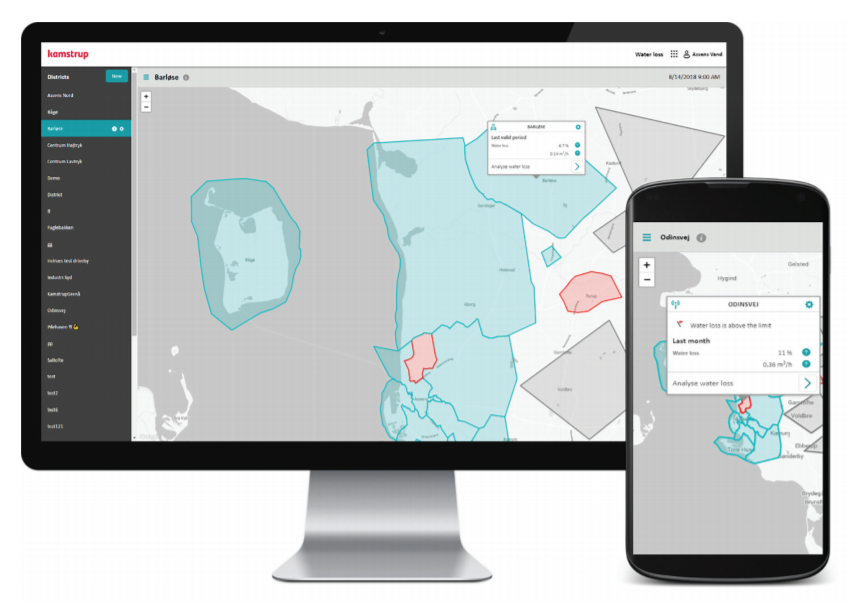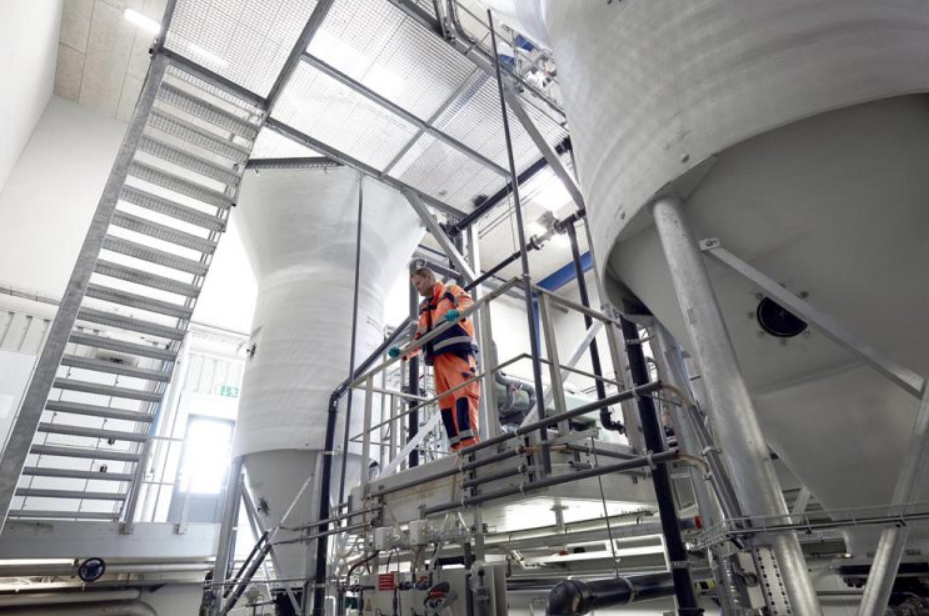
Technosens
ID: 4182
11. maj 2022
Technology facilitates “senior ready” living environments to support residents, their families and care providers.
ID: 3463
24. september 2021
Herning Vand, a Danish water utility company, has been on an ongoing journey to reform the water sector and shed light on the scarcity of potable water as a resource by informing consumers about consumption and supply of water in their local community. Herning Vand had already implemented several initiatives over the years, but one key challenge remained: to persuade users to develop an interest in their water supply and to really change their water consumption mindset.
When several outdated water meters were up for renewal, Herning Vand reckoned a chance to boost the overall initiative strategy, enabled by digital technologies and the Internet of Things (IoT). This initiated the collaborative SMARTmeter project.
Herning Vand is an independent utility company that provides clean water and manages wastewater in Herning municipality in Denmark. Stimulated by reformation and a range of fusions within the sector, the company was founded in 2000 and has since served as a guarantor of water supply with high environmental quality and socio-economic accountability. Herning Vand has three waterworks at disposal which are supplied with water collected from 20 drilling holes located near the city centre of the municipality at depths up to 190 metres deep.
Herning Vand’s objective is to ensure that households have access to clean drinking water in their taps and that they are able to dispose of their wastewater. Herning Vand supplies drinking water to 17.000 households and handles wastewater from 34.000 households in Herning municipality. Furthermore, Herning Vand actively participates in the planning and realisation of climate adaptation solutions for new and existing areas in the municipality. About 70 people collaborate across the areas of supply, purification and environment, with an operational aim to deliver healthy water at the lowest price possible.

Herning Vand has embarked on a digital journey motivated by a desire to be at the forefront of future challenges and to ensure sustainable development. The digital strategy of the company is based on the challenges faced in everyday life and the incentive to deploy IoT by replacing old water meters with digital alternatives. In 2019, more than a third of Herning Vand’s existing water meters failed to meet technical standards, causing replacement to be a necessity. The choice of a more contemporary and digital alternative seemed obvious to Herning Vand.
“One of the major reasons we started implementing digital water meters was the customer service.”
Jeanette D. Andersen, Project & Development Coordinator at Herning Vand
By replacing the outdated water meters with a digital solution, Herning Vand is able to remotely access water meters, and reading water usage and waste has become automated. This removes the need for manually reading the meters, thus eliminating inconvenient and untimely disturbances for the customers. Furthermore, meter reading is more accurate with automation, thus optimising the billing process and consumption surveillance.

The digital water meters are a residential model named MULTICAL 21. This model uses ultrasonic waves to measure the speed of water flow, and thereby the consumption of water. The flow measurement is sent to a data cloud through a wireless smart connection that enables Herning Vand and the customers to read and monitor the water consumption through an application. The following illustration demonstrates a simplified version of the IoT architecture and data flow.

The digital water meter is able to detect water flows as low as 2 L/Hour, which makes the measurement accurate and enables detection of potential water leaks inside a household. If a leak occurs, the meter has a build-in intelligent alarm system, which alerts the customers of any leak, pipe burst, reverse flow or tampering. The customers and Herning Vand will be notified about the accrual problem with a text message to prevent water loss and collateral damage to the house.
It was a crucial priority for Herning Vand to find an appropriate partner to deliver the solution and support throughout the process of implementation. To do so, the company held a pre-qualification meeting with three selected system suppliers, who then competed on their ability to offer the best solution. The Danish company Kamstrup was chosen due to product reliability, references and experience. Herning Vand chose to replace all existing water meters with the solution offered by Kampstrup, implying that 17,000 digital water meters are installed and functioning in households in the municipality of Herning at present.

Herning Vand experienced positive impacts of implementing the digital water meters on all of their three button lines, entailing both financial, social and environmental effects. All the effects derive from the profound data accessibility effectuated by the IoT.
“With the new digital water meters, we have a more detailed picture and a more detailed data set that we can use for many purposes.”
Jeanette D. Andersen, Project & Development Coordinator at Herning Vand
On the financial line, a noticeable outcome is that the IoT has automated the entire billing process, making it more accurate and significantly faster for the benefit of both the Herning Vand and its customers. The automated reading of citizens’ water consumption has reduced the need for human resources in terms of manual labour. The improved accuracy of the metering, which is caused by the ultrasonic measuring capability of the device, has reduced the risk of wear and tear. Ultimately, this has allowed Herning Vand to use less energy for water pumping and to optimize technical maintenance, which extends the lifespan of the pipes.
On the social line, Herning Vand has integrated the data into a portal solution with a ‘my page’ feature, which allows customers to monitor their use of water and customise an alert system.
“It means that we can offer the customers assurance that they do not spend loads of money just by pouring it into the ground.”
Jeanette D. Andersen, Project & Development Coordinator at Herning Vand
Ultimately, the alert system enables Herning Vand to fulfil a need for security, which customers regard as an augmented service. Ultimately, the feature increases consumption awareness and enables the citizens to reduce their water usage and save money. Herning Vand further recons the increased awareness as a source of enriched customer contact and communication, which has promoted the appreciative perception of clean water as a privilege.

On the environmental line, the IoT solution saves the planet water and feeds directly into several of the United Nation’s sustainable development goals. The CEO of Herning Vand, Niels Møller Jensen, sees vast potential for the specific IoT solution globally.
“The technology can help prevent theft, waste and over-consumption of water in a world where water is a scarce resource.”
Niels Møller Jensen, CEO at Herning Vand

Herning Vand finds two particular factors to be fundamental for their success throughout their digital encounters. Firstly, the company advocates that a digital strategy is vital to lead any initiative, and for the initiatives to prosper, they must be stimulated by value creation for either customers or employees. Secondly, the company finds it crucial to build a culture around digitalisation that truly incorporates the mentality throughout the organisation. So far, existing resources have been sufficient for the work with IoT, however Herning Vand has learned that digitalisation causes a natural need for new skills and capabilities to be added to the organisation.
“As the development is insanely fast-paced I believe that we will be looking towards specialists along the way.”
Niels Møller Jensen, CEO at Herning Vand
With regard to this, the CEO finds it important for leaders to stress to their employees that digitalisation initiatives are not pursued to eliminate jobs – only the boring and ineffective parts of the jobs.
By thinking digital into problem solving, Herning Vand has witnessed a reinforcement of the manifested connection between internal and external spheres. Even though the value of implementing IoT was originally thought to be extracted for internal optimisation, this value seems to have radiated externally to customers and partners. Herning Vand’s use of the technology and data has aroused curiosity among other companies, and effectuated new partnerships, collaborative projects and a considerable extension of their network. This is enforced reversely as well, in the commencing cooperation with Kamstrup to deliver the IoT solution.
“It is our experience that projects succeed the best through partnerships.”
Niels Møller Jensen, CEO at Herning Vand
Openness and trust within the partnership is pointed out as a key success factor, serving also as the foundation for the partners to continuously explore potential for new services and identify synergies from coupling extant internal data with the external data. Hence, the value of the IoT data seems to radiate endlessly throughout the ecosystem.
The major, and most basic, learning has really been for Herning Vand to recognise the value of collecting and leveraging data. The profound insights have helped the company connect better with their customers by enabling them to offer a customised and personalised service, entailing closer and more rapid contact, making the citizens ever more interested in their water consumption. Looking towards the future, Herning Vand expects greater consolidation within the sector and consider this recent effort towards digitalisation as essential for positioning the company, well as a capable and promising candidate in the race for continual survival.
The collection and leverage of data enabled by the intelligent water meters holds additional potential for Herning Vand to internally capture profound amounts of value.
By combining the existing pool of static data, for example on the pipe system and infrastructure, with the new continuous pool of dynamic data, Herning Vand has an unprecedented overview of their assets. The digitalisation and improved accuracy of the metering is enabled by the ultrasonic measuring capability of the device, which reduces the risk of wear and tear.
“The technical department is given the opportunity to work with the many data in relation to a concept called asset management.”
Niels Møller Jensen, CEO at Herning Vand
Through criticality analysis, this has facilitated new insight into the condition of the water pipes, which enables pressure tuning and optimized technical maintenance. Ultimately, it allows Herning Vand to use less energy for water pumping and to extend the lifespan of the pipes.
By leveraging the data for criticality analysis, Herning Vand has significantly strengthened their foundation for asset efficiency and performance, operational optimizations and informed decision-making for future asset investments. Ultimately, it will lead water and wastewater supply to become even cheaper, creating value also for the customers. Finally, the digital data holds the potential for prescriptive asset management, in terms of predictive maintenance and predictive resource allocation and planning.


Herning Vand assumes a relatively high level of digital maturity with an overall score of 3.49. The score indicates that the digital capabilities of the company are vastly mature, and that they perform above average for the sector.
The Digital Maturity Assessment Tool is developed and copyright by Associate Professor and PhD Annabeth Aagaard, Director at the Interdisciplinary Centre for Digital Business Development, Aarhus University. To get the digital maturity of your company mapped out, click here.

Copyright notice: © 2020 – 2023 EU-IoT Consortium.
This material was produced as part of the EU-IoT project, grant ID 956671, and is funded by the Horizon 2020 Framework Programme under topic ID ICT-56-2020.
EU-IoT is the European IoT Hub. The EU-IoT project works towards growing a sustainable and comprehensive ecosystem for Next Generation Internet of Things.
Source of origin: Information to document this use case originates from the projects MEREFF MST-141-01596 and MERMISS NST-404-00217; Period: 2014 to 2020; The Danish Environmental Protection Agency contribution 2.5 mil. EUR.
